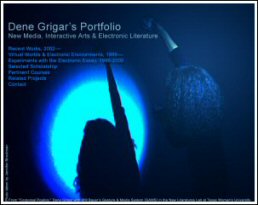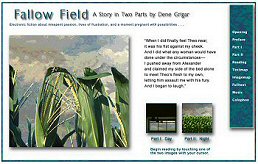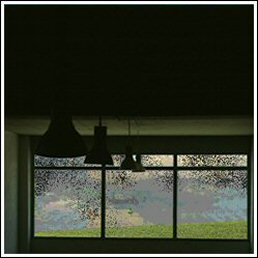


|
The Role of Sound in Electronic Literary Works
What is the role of sound in new media narratives and poetry, particularly those classified as electronic literature? This question is explored in a presentation concerning the relationship between sound and words in fiction and poetry of the media arts.
Focusing solely on web-based works because of their easy accessibility to audiences, the presenter will discuss several works found at the Electronic Literature Organization Directory that, along with visual elements and words, utilize sound in works of fiction or poetry. Specifically, she will begin by looking at those works in which sound and music are used as auxiliary elements at the service of words, such as M.D. Coverley's "The Lacemaker" and Patricia Monaghan's "Examination." Following that, she will show works that attempt to incorporate sound more closely with the work in a way that emphasizes sound as a crucial element in the piece. John Kusch's "Red Lily," Young-Hae Chang Heavy Industries' "Samsung," and several of Ana Maria Uribe's “Anipoems” will be shown as examples of this type of approach. Finally the presentation will end with a discussion of electronic literary works that make sound the leading element in the narrative. Here the author will show Mark Amerika's Filmtext and her recent piece, "When Ghosts Will Die," a narrative performance-installation created by multimedia artist and musician, Steve Gibson.
While many studies, such as Mary Hocks and Michelle Kendricks' Eloquent Images: Word and Image in the Age of New Media, and Jan Van Looy and Jan Baetens' Close Reading New Media: Analyzing Electronic Literature, and even Noah Waldrip-Fruin and Pat Harrigan's First Person: New Media as Story, Performance, and Game, discuss the relationship between visual and verbal texts, little has been produced that theorize or analyze works that incorporate sound with these elements. Thus, this presentation seeks to add to current understanding of electronic literary works by exploring this under theorized, and important, area of research.
This selection of websites and DVD allows for discussion of the relationships between digital interfaces and the different techniques and levels of juxtaposition and recombination they allow. They should stimulate a debate on how digital media make the interactor more aware of the language recombination possibilities available in formats that move away from point-and-click, on portals all over the web, and remote controlled selection of sequences, on DVDs for rental at your local video stores.
|

